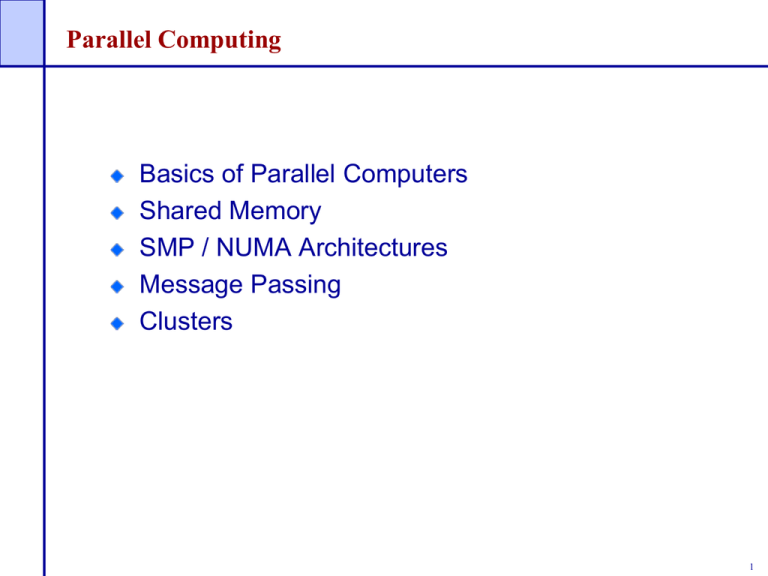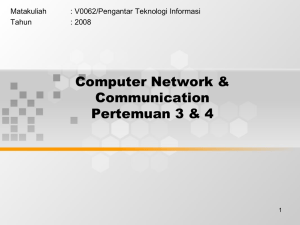Parallel Computing Basics of Parallel Computers Shared Memory SMP / NUMA Architectures
advertisement

Parallel Computing
Basics of Parallel Computers
Shared Memory
SMP / NUMA Architectures
Message Passing
Clusters
1
Why Parallel Computing
No matter how effective ILP/Moore’s Law, more is
better
Most systems run multiple applications simultaneously
Overlapping downloads with other work
Web browser (overlaps image retrieval with display)
Total cost of ownership favors fewer systems with multiple
processors rather than more systems w/fewer processors
Adding processor/memory much
cheaper than a second complete system
Price
Peak performance increases linearly
with more processors
2P+M
2P+2M
P+M
Performance
2
What about Sequential Code?
Sequential programs get no benefit from multiple processors,
they must be parallelized.
Key property is how much communication per unit of computation.
The less communication per unit computation the better the scaling
properties of the algorithm.
Sometimes, a multi-threaded design is good on uni & multiprocessors e.g., throughput for a web server (that uses system
multi-threading)
Speedup is limited by Amdahl’s Law
Speedup <= 1/(seq + (1 – seq)/proc)
as proc -> infinity, Speedup is limited to 1/seq
Many applications can be (re)designed/coded/compiled to
generate cooperating, parallel instruction streams – specifically
to enable improved responsiveness/throughput with multiple
processors.
3
Performance of parallel algorithms is NOT limited by
which factor
1.
2.
3.
4.
The need to synchronize work done on different
processors.
The portion of code that remains sequential.
The need to redesign algorithms to be more
parallel.
The increased cache area due to multiple
processors.
4
Parallel Programming Models
Parallel programming involves:
Decomposing an algorithm into parts
Distributing the parts as tasks which are worked on by multiple
processors simultaneously
Coordinating work and communications of those processors
Synchronization
Parallel programming considerations:
Type of parallel architecture being used
Type of processor communications used
No automated compiler/language exists to automate this
“parallelization” process.
Two Programming Models exist…..
Shared Memory
Message Passing
5
Process Coordination
Shared Memory v. Message Passing
Shared memory
Efficient, familiar
Not always available
Potentially insecure
global int x
process foo
begin
:
x := ...
:
end foo
process bar
begin
:
y := x
:
end bar
Message passing
Extensible to communication in distributed systems
Canonical syntax:
send(process : process_id, message : string)
receive(process : process_id, var message : string)
6
Shared Memory Programming Model
Programs/threads communicate/cooperate via
loads/stores to memory locations they share.
Communication is therefore at memory access speed
(very fast), and is implicit.
Cooperating pieces must all execute on the same
system (computer).
OS services and/or libraries used for creating tasks
(processes/threads) and coordination
(semaphores/barriers/locks.)
7
Shared Memory Code
fork N processes
each process has a number, p, and computes
istart[p], iend[p], jstart[p], jend[p]
for(s=0;s<STEPS;s++) {
k = s&1 ; m = k^1 ;
forall(i=istart[p];i<=iend[p];i++) {
forall(j=jstart[p];j<=jend[p];j++) {
a[k][i][j] = c1*a[m][i][j]
+ c2*a[m][i-1][j] +
c3*a[m][i+1][j] + c4*a[m][i][j-1] +
c5*a[m][i][j+1] ; // implicit comm
}
}
barrier() ;
}
8
Symmetric Multiprocessors
Several processors share
one address space
conceptually a shared
memory
Communication is implicit
read and write accesses to
shared memory locations
P
P
P
Synchronization
via shared memory
locations
spin waiting for non-zero
Atomic instructions
(Test&set, compare&swap,
load linked/store
conditional)
barriers
Network
M
Conceptual Model
9
Non-Uniform Memory Access - NUMA
CPU/Memory busses cannot
support more than ~4-8 CPUs
before bus bandwidth is
exceeded (the SMP “sweet
spot”).
To provide shared-memory MPs
beyond these limits requires
some memory to be “closer
to” some processors than to
others.
P1
P2
Pn
PN
$
$
$
$
Interconnect
M
M
The “Interconnect” usually includes
a cache-directory to reduce snoop traffic
Remote Cache to reduce access latency (think of it as an L3)
Cache-Coherent NUMA Systems (CC-NUMA):
SGI Origin, Stanford Dash, Sequent NUMA-Q, HP Superdome
Non Cache-Coherent NUMA (NCC-NUMA)
Cray T32E
10
Message Passing Programming Model
“Shared” data is communicated using “send”/”receive” services
(across an external network).
Unlike Shared Model, shared data must be formatted into
message chunks for distribution (shared model works no matter
how the data is intermixed).
Coordination is via sending/receiving messages.
Program components can be run on the same or different
systems, so can use 1,000s of processors.
“Standard” libraries exist to encapsulate messages:
Parasoft's Express (commercial)
PVM (standing for Parallel Virtual Machine, non-commercial)
MPI (Message Passing Interface, also non-commercial).
11
Message Passing Issues
Synchronization semantics
When does a send /receive operation terminate?
Blocking (aka Synchronous):
Sender
Sender waits until its message is received
Receiver waits if no message is available
OS Kernel
Receiver
Non-blocking (aka Asynchronous):
Send operation “immediately” returns
Receive operation returns if no message is
available (polling)
Sender
OS Kernel
Receiver
Partially blocking/non-blocking:
send()/receive() with timeout
How many buffers?
12
Clustered Computers designed for Message Passing
A collection of computers (nodes)
connected by a network
computers augmented with fast
network interface
send, receive, barrier
user-level, memory mapped
otherwise indistinguishable from
conventional PC or workstation
Node
P
P
P
M
M
M
One approach is to network
workstations with a very fast
network
Often called ‘cluster computers’
Berkeley NOW
IBM SP2 (remember Deep Blue?)
Network
13
Which is easier to program?
1.
2.
Shared memory
Message passing
14




